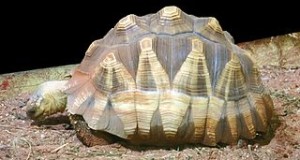Please see Part I of this article for tips on using oyster shell for desert dwelling lizards and tortoises. Today we’ll explore the use of rabbit pellets for herbivorous reptiles and their important role in preventing leg deformities in hatchling tortoises.
Rabbit Pellets for Hatchling Tortoises
Rabbit pellets? Yes…surprisingly, rabbit pellets are useful to herp keepers in several ways.
Hatchling tortoises that are housed on hard, unyielding substrates (i.e. newspaper over a bare floor, packed bark-based products) very often develop splayed legs. Eventually, the animal is left in a fairly crippled condition; corrective measures are relatively ineffective after a certain point.
Rabbit pellets used as a cage substrate provide exactly the right consistency for all newly hatched tortoises. I have raised many broods of star (Geochelone elegans), leopard (G. pardalis), radiated (Astrochelys radiata) and other tortoises on rabbit pellets with great results.
Rabbit and Alfalfa Pellets as Food
 Additionally, rabbit pellets are useful as a substrate for older tortoises, green iguanas (Iguana iguana) and other herbivorous lizards. Comprised largely of alfalfa, they are a fine food item for these creatures, and so can be swallowed with impunity by animals that drag damp salad out of their feed bowls. This fact is gaining acceptance among reptile keepers…so much so that R Zilla now manufactures an alfalfa pellet specifically for use as a reptile substrate.
Additionally, rabbit pellets are useful as a substrate for older tortoises, green iguanas (Iguana iguana) and other herbivorous lizards. Comprised largely of alfalfa, they are a fine food item for these creatures, and so can be swallowed with impunity by animals that drag damp salad out of their feed bowls. This fact is gaining acceptance among reptile keepers…so much so that R Zilla now manufactures an alfalfa pellet specifically for use as a reptile substrate.
Rabbit and alfalfa pellets clump when wet, quickly revealing areas in need of spot cleaning. As they are likely to be eaten, it is important that the pellets used as a substrate are kept fresh and clean. Alfalfa pellets support fungal growth, and therefore are not suitable for use with desert-dwelling reptiles (please see Part I of this article for further details).
Over-Eating
Overconsumption of rabbit pellets reputedly results in overly high protein levels for some tortoises. Although I am not aware of any specific incidences of this, rabbit and other alfalfa pellets in and of themselves do not provide any tortoise with a balanced diet, so their intake should be monitored. In my experience, most tortoises eat rabbit pellets accidentally, along with salad, and do not specifically seek them out.
 That Reptile Blog – Reptile, Amphibian and Exotic Pet Care and Information
That Reptile Blog – Reptile, Amphibian and Exotic Pet Care and Information




I have seen many young tortoises become not only dehydrated from being kept on rabbit pellets, but also permanently deformed. The “splay leg” condition that the author mentions is also created by the difficulty they find walking on the pellets. Long term muscle and joint issues arise. Because the pellets mold quickly when exposed to moisture, they make it impossible to create a humid micro-climate such as young tortoises would find in the wild, as they spend most of their time hiding in humid burrows and at the base of plants while they are small and still very vulnerable to predators. Dry conditions and dehydration can lead to kidney problems and exacerbate pyramiding. Molds in the rabbit pellets can lead to respiratory problems as well. I strongly recommend seeking other opinions and doing more research before opting to use rabbit pellets as substrate for tortoises.
Hello Kristina, Frank Indiviglio here.
Thanks for your interest in our blog and insightful comments.
While some very knowledgeable people have cautioned against alfalfa pellets, my experience does not bear such out, assuming the pellets are used and maintained properly.
I have not, for example, observed any developmental problems/splay leg associated with the use of alfalfa pellets.
Dehydration can occur due to a wide variety of factors; I have read of it as being associated with alfalfa pellets but have not seen evidence that the pellets were at the root of the condition. Providing appropriate shelters, a proper diet and access to water would, I believe, be the best way to address that concern.
Mold is always an issue if the substrate is not cleaned appropriately; for especially sensitive species, i.e. Egyptian Tortoises, oyster shell is a safe alternative (although too hard a substrate for hatchlings).
I generally advise folks to provide species-appropriate caves and similar shelters, and to use heat and light judiciously, in order to create micro-climates/habitats. If kept clean and dry, pellets should not interfere with this.
Good luck, enjoy and please keep me posted.
Best regards, Frank Indiviglio.
I have encountered the same on the web. In fact yours is the first opinion I read praysing rabbit pellets. Everywhere it is said that they can cause foot deformities and that they rot quickly upon moisture. The latter, as you mentioned too, is a real problem. Isn’t a sand soil mix in the required ratios for tortoises of different climates the best substrate? At least most tortoise websites recomend that.
Furthermore, I own a rabbit and I consider putting its food for a reptile just to walk and poop on, and once in a while eating a little, at least objectionable, especially as alternatives exist. Food, either human or animal, must not be thrown casually in my opinion.
Hi,
It’s standard in zoos for some species; care needed as mentioned; sand fine as well as long as research is done as to proper mix, etc. Other is a matter of opinion – tons of alfalfa (main ingredient in the pellets) are, in the form of hay, used as bedding for domestic stock and zoo animals worldwide, best, Frank